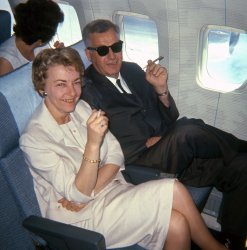
MAY CONTAIN NUTS

Search Shorpy
SHORPY ART

Framed or unframed, desk size to sofa size, printed by us in Arizona and Alabama since 2007. Explore now.
Join and Share
Ad-Free Shorpy
Shorpy is funded by you. Patreon contributors get an ad-free experience.
Learn more.

Recent comments
- Freeze Frame
- Texas Flyer wanted
- Just a Year Too Soon
- WWII -- Replacing men with women at the railroad crossing.
- Yes, Icing
- You kids drive me nuts!
- NOT An Easy Job
- I wonder
- Just add window boxes
- Icing Platform?
- Indiana Harbor Belt abides
- Freezing haze
- Corrections (for those who care)
- C&NW at Nelson
- Fallen Flags
- A dangerous job made worse
- Water Stop
- Passenger trains have right of way over freights?
- Coal
- Never ceases to amaze me.
- Still chuggin' (in model form)
- Great shot
- Westerly Breeze
- For the men, a trapeze
- Tickled
- Sense of loneliness ...
- 2 cents
- Charm City
- What an Outrage
- Brighton Park
Member Photos
The Shorpy
Print Emporium
Print Emporium
Search Shorpy
Search results -- 30 results per page
- Tourists of Doom: 1906
- ... "Ruins of Stanford Mansion and Hopkins Art Institute, San Francisco." Aftermath of the April 18, 1906, earthquake and fire. 8x10 glass ... Posted by Dave - 11/30/2016 - 6:34pm -
![Tourists of Doom: 1906 "Ruins of Stanford Mansion and Hopkins Art Institute, San Francisco." Aftermath of the April 18, 1906, earthquake and fire. 8x10 glass negative. View full size.
Look On the Bright Side...At least the lamps survived.
110 years onThere's a good pre-earthquake photo of the mansion from almost the same angle at:
http://www.ronhenggeler.com/the_big_4/1-15.htm
Now the "Renaissance San Francisco Stanford Court Hotel" is on the site at California & Powell streets in SF:
What's leftInteresting - that square utilities pole. Looks like possibly constructed of concrete. And, typical of devastating fires, nothing left except for the chimneys.
Before and AfterI found this image from nearly the same spot before the fire. The burned tower in the background of the Shorpy photo is still under construction in this image.
Caught off guardAn interesting cross-section of the city's population, including three U.S. Marines, captured apparently unaware of the photographer's presence. It would seem that a relatively fast-acting camera was used, based on the motion captured in the frame.
[Daylight exposures of fractions of a second were commonplace by this time. -tterrace]
Well dressed even in disaster...Amazing how well turned out these people are in the midst of their ruined city complete with attractive hats, coats and dresses. They even have their Brownie cameras in tow (I am guessing that is what is being carried by the man in the foreground)
How Long After ?I wonder how long after the fire that this was taken? The large utility pole seems to have more guy wires anchored to it than service wires on its cross arms while another wooden one (without any wires) looks, fresh even with all the spiked-boot climbing evidence on it.
Also, the irony of the fire hydrant - likely rendered useless if the quake sheared the mains supplying it. Some SF buildings had private cisterns, which in a few rare cases mitigated damage.
Another curious survivorThe monkey puzzle tree in the front yard.
(The Gallery, DPC, Fires, Floods etc., San Francisco)](https://www.shorpy.com/files/images/SHORPY-4a13257a.thumbnail.jpg)
- Stakes and a Grille: 1940
- San Francisco, 1940. "International stake bed truck." Ready to roll up its sleeves ... St. The building dates from 1915 and now is part of the San Francisco Design Center complex. Buildings on the left are gone, the space ... Posted by Dave - 08/11/2018 - 12:17pm -
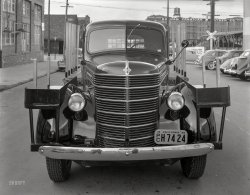
- What a Dumper: 1918
- San Francisco circa 1918. "Peerless truck." With a dump body by Modern Vehicle Company of San Francisco. 5x7 glass negative by Chris Helin. View full size.
What ... Posted by Dave - 08/11/2016 - 3:06pm -
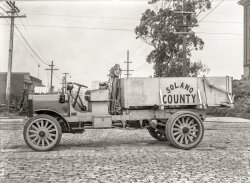
- Que Sera, Sera: 1922
- San Francisco circa 1922. "Dorris touring car at Shreve & Co." Latest entry in ...
(The Gallery, Cars, Trucks, Buses, Chris Helin, San Francisco, Stores & Markets) ... Posted by Dave - 01/21/2015 - 2:30pm -
![Que Sera, Sera: 1922 San Francisco circa 1922. "Dorris touring car at Shreve & Co." Latest entry in the Shorpy Parade of Archaic Chariots. Photo by Christopher Helin. View full size.
Well-known locationLittle has changed, down to the streetlamps, although I suspect the prices are a bit different.
Archaic chariots!Classic. And they probably thought they were the best.
Shreve & CompanyCorner of Post and Grant, a block down from Union Square.
View Larger Map
A Perfect Exampleof why we refer to the trunk as a "trunk."
Almost Over My Headbut on my second read I got the "Que Sera, Sera" reference. A title well written.
Neat history on this bldg.right here.
YuchNothing to do with the picture you posted, but I had to clean off the remains of my breakfast from my keyboard. Any chance of making Shorpy a paid-site so we can avoid advertisements like this?
[We'll let you know as soon as your check arrives! - Dave]
The future's not ours to seeSadly, 1923 would be the last year of production for the costly and hand-built Dorris motor car.
Doriss LivesNow I get it, but it took several minutes!
I get it tooA fine looking day to be driving a Dorris.
(The Gallery, Cars, Trucks, Buses, Chris Helin, San Francisco, Stores & Markets)](https://www.shorpy.com/files/images/SHORPY-198-02.thumbnail.jpg)
- Don Lee Cadillac: 1925
- San Francisco, 1925. "Type V-63 Sedan at Don Lee Cadillac." Back when "power ... Earl got his start in auto design. I suppose that Lee's San Francisco clientele could avail themselves of that service as well.
... Posted by Dave - 03/22/2016 - 12:56pm -
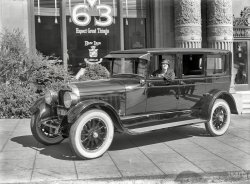
- Six in the Park: 1929
- San Francisco, 1929. "Hudson Super Six." Strangers when they met, until he took ... but not him.
Today's Palace of Fine Arts Many San Franciscans would be surprised to learn that the beautiful and iconic ... Posted by Dave - 02/15/2015 - 9:32pm -
![Six in the Park: 1929 San Francisco, 1929. "Hudson Super Six." Strangers when they met, until he took her for a ride. 5x7 inch glass negative by Christopher Helin. View full size.
A Robust RideHudsons were well constructed and solidly middle-class cars. That sedan probably weighs as much as four of today's Formula 1 racers and thanks to its torque-rich, long stroke engine, could probably accelerate smoothly from a walking pace to 45 MPH in ... oh, I don't know -- how much time have you got?
[Curb weight of this five-passenger sedan was about 3,700 pounds, or two and a half Formula 1 cars. -Dave]
The Joads' JalopyIt was a Hudson Super Six that starred as the Joads' decrepit jalopy in John Steinbeck's signature 1939 novel, "The Grapes of Wrath." After ten appalling years of the Great Depression, it must have been hard to know which were more worn out: 1920s autos or the hapless Americans who were still driving them.
Palace of Fine ArtsPart of the 1915 Panama-Pacific International Exposition, sort of a world's fair for the City, the only remaining buildings. Lovely part of the City!
A la modeI am very interested in menswear, especially business wear, and it is fascinating to me how contemporary the fellow in this photo looks. The cut of the suit, the shoes, the haircut - all could as easily be 2015, even though this picture is 86 years old. You can place the woman and the car in period, but not him.
Today's Palace of Fine ArtsMany San Franciscans would be surprised to learn that the beautiful and iconic Palace of Fine Arts in the City's Marina District is actually a 1965 replica of the original from the 1915 Exposition.
Us kids, roaming around San Francisco in the early '60s, often played at the old Palace. It was in terrible shape, actually rotting away with the poor quality burlap and plaster finish falling off the wood lath beneath. It had never been intended to last longer than the expo and wasn't permanent.
Fortunately, San Francisco couldn't let it go and so they completely rebuilt the Palace on site in permanent materials.
Here's a photo by Kevin Cole:
(The Gallery, Cars, Trucks, Buses, Chris Helin, San Francisco)](https://www.shorpy.com/files/images/SHORPY-252-02A.thumbnail.jpg)
- Body by Fisher: 1940
- ... Motors exhibit at Golden Gate International Exposition, San Francisco. Transparent Car with Pontiac Chassis and Body by Fisher." And what a ... Posted by Dave - 03/29/2015 - 1:22pm -
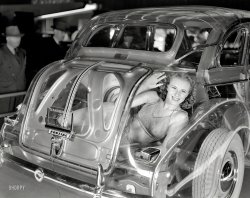
- Custom Chassis: 1923
- ... And Clyde.
Mysterious obelisk We're in what is now San Francisco's Marina District, on what had been the grounds of the 1915 ... Posted by Dave - 11/05/2014 - 8:23am -
![Custom Chassis: 1923 What with one 1920s car looking pretty much like the next, the enterprising automotive photographer had to juice things up as best he could. Here, for instance, we have the rake of sunlight and mysterious background obelisk as points of interest, sparking an artsy three-quarters view. Oh, and big headlights.
The Bay Area in 1923. "Peerless touring car." Fully equipped with two spares. 6½ x 8½ inch glass negative from the Wyland Stanley collection. View full size.
Bonnie and ConnieAnd Clyde.
Mysterious obeliskWe're in what is now San Francisco's Marina District, on what had been the grounds of the 1915 Panama-Pacific International Exposition. The obelisk is the Column of Progress, which had stood in the Court of Abundance, at about what's now the intersection of Beach Street and Cervantes Boulevard. It was finally torn down sometime in the mid- to late-1920s. Another survivor from this World's Fair, the Palace of Fine Arts, is off frame to the left; it stood deteriorating until 1964, when it was demolished to be replaced by the present reconstruction.
[Court of Abundance, indeed. I just knew tterrace would know! -Dave]
Hey Babe, check out my ...The Column of Progress in its original, less lonely context.
Corporate Evolution (continued)Peerless was one of the Three Ps of luxury motoring (along with Packard and Pierce-Arrow), but by 1932, the Cleveland manufacturer was addressing a vanishing clientele ... or, at least, a reluctant one.
Ever resourceful, the company's directors switched to making the next best thing: Carling Black Label beer and Red Cap Ale.
Don't ForgetYour shoesies!
StockingsWhat was with the rolled down stockings back then? Were women not allowed to show their bare ankles or was it just the fashion?
One flivverand two flappers.
I have a preferenceBut I don't want to be unkind. Let's just say I like the Peerless one.
Rolled stockimgsI can only say that my dear Grandma wore rolled stockings to the end. That was in the 70s and she cut off pantyhose (L'eggs) to wear what she did when she came of age. She was the best!
Prepared for off-road useObviously getting ready for an extended cross-country jaunt over roadless terrain - why else would you have two wenches on the front bumper?
Yes Indeed!I too noticed the large and lovely headlights and I think I'll leave it at that.
What sleek lines.I'll take one! Oh heck, I'll take them both and the car too.
Upon further investigationI just realized there is a person in the driver's seat.
DagmarsMiss Peerless may have the advantage on the eyes, but her sense of balance is not on a par with her bumper partner. The blur in her hands shows she was still trying to establish it as the photo was taken.
Very niceI wish the headlights were not so obstructed as to get a better view. Wonderful body lines on that car.
(The Gallery, Cars, Trucks, Buses, Pretty Girls, San Francisco, W. Stanley)](https://www.shorpy.com/files/images/SHORPY-141105-0001B.thumbnail.jpg)
- Harbor Patrol: 1960
- ... with boats, but full of location photography in the San Francisco of 1958. -tterrace]
Patched Up The officer on the left wears ... Posted by Dave - 01/08/2023 - 4:36pm -
![Harbor Patrol: 1960 UPDATE: For the story behind this photo, click here and scroll down to the comments.
October 2, 1960. Richmond, California. "Harbor Patrol." Rickey Stowell helming a Glasspar Seafair. 4x5 inch acetate negative from the Shorpy News Photo Archive. View full size.
3 It was only supposed to be a 3 hour tour.
Adjust the rabbit earsI remember this TV show. The only character missing in this photo is little Billy's dog Sparky, which was always coming to the rescue in the nick of time.
El TorosLooks like part of the Richmond Yacht Club's fleet of El Toro dinghies in the background.
TV shows galoreThis one reminds me of Harbor Command staring Wendell Corey on TV 1957-58. It was supposed to be the workings of the US Coast Guard but I don't remember Corey in uniform. It was a good show though. Yes, the man on the right does look like the Skipper (Alan Hale, Jr.) in the Gilligan TV show.
["Harbor Command" was a fictional organization created for the TV show of that name. It was basically "Highway Patrol" with boats, but full of location photography in the San Francisco of 1958. -tterrace]
Patched UpThe officer on the left wears a shoulder patch that dates from the 1940s, although some versions had the letter P between the wings. The officer on the right is sporting a patch that features a view of Shimada, Japan, which became Richmond's sister city in October 1961.
Sam Brown duty belt with issue "dump pouch"These fine looking officers were wearing the standard issue brand belts for many years. I first bought and was later issued these Sam Brown duty belts with bullet dump boxes. My dump boxes held 6 bullets each which gave me a total of 18 rounds.
I just bet these officers were carrying Model 10 Smith and Wesson Revolvers. Possibly an earlier model, not sure.
Those were the days --
(The Gallery, Boats & Bridges, Kids, News Photo Archive)](https://www.shorpy.com/files/images/SHORPY-431-01.thumbnail.jpg)
- Apocalypse Then: 1906
- ... "Looking up Market St. from near Ferry." Another look at San Francisco in the aftermath of the earthquake and fire of April 18, 1906. View ... Posted by Dave - 08/21/2012 - 5:17pm -
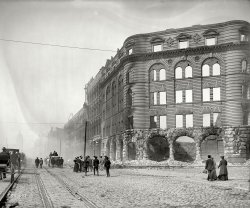
- Jimmy & Billy: 1914
- April 3, 1914. San Francisco (Daly City). "Jim Clabby & Bill Murray." Middleweight champion ... goes Daly City is just over the county line from San Francisco, and it was there that San Franciscans went to indulge in ... Posted by Dave - 02/03/2022 - 12:28pm -
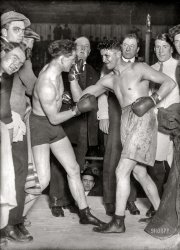
- The Washboard Jungle: 1900
- ... Our Mother used one of these when we lived in a flat in San Francisco. When the wind whipped the clothes over and over the lines, it was ... Posted by Dave - 07/26/2012 - 4:52pm -
![The Washboard Jungle: 1900 "New York tenement yard c. 1900-10." One of the better surviving images of turn of the century tenement life. Detroit Publishing glass negative. View full size.
Pulley ClotheslinesOur Mother used one of these when we lived in a flat in San Francisco. When the wind whipped the clothes over and over the lines, it was murder trying to get them reeled back in. (Note the clothesline on the topmost left.) I wonder who shinnied up those poles to attach the the pulleys. Probably a kid like Shorpy. A long way down the steps to the courtyard if you dropped a sock.
Green SheetsIt may just look like clothing hung out to dry, but I see a linear solar-powered fabric dehydrator.
PantaloonsNo tighty whiteys here
Whites OnlyWas this a day for only washing whites? Because that must be 80% of the clothes here. Or did people back then wear very few darks and coloureds? I know in my household, whites make up a small fraction of our laundry.
[I think I see some grays. - Dave]
What got washed.The whites were the items most washed, dark clothes were the wool coats, hats, dresses, even pants, that were not washed every week like underwear and shirts.
I wonder if the idea of a "washday" was so that the courtyard only looked like this one day a week.
For the birdsI'd sure hate it if a flock of pigeons flew by.
Bird HeavenYou would think there would be a problem with pigeons sitting on the lines.
Scenes like this always remind me of the old cartoons where a character falls from a plane or something, goes through the lines and ends ends up safely on the ground dressed in some odd combination of apparel he accumulated along the way.
Air-DriedThere's nothing like clean sheets and towels fresh from the line. Tumble-drying is a poor substitute.
East End AvenueIt looked a lot like that in the 1940's too. I lived with my folks at 48 East End Avenue, not far from Gracie Mansion in Carl Shurtz Park. It was not glam in those days, and we lived in a second floor apartment above a liquor store and florist shop. Out the back were the usual New York back yards above which were the spider web of laundry lines, many of which did go from building to building. I've got a painting my dad did of the view out the living room window, and also paintings of the ice house that burned in a fire around the corner from us. From the Park we could watch the progress as the UN building was built.
WashdayI had an acquaintance many years ago from the Boston area. Every Wednesday you could count on him for at least two or three call-outs for "Wednesday Washday." So that makes me think you might be onto something.
Now that this particular photo shows the poles on which the pulleys were attached, it clears up my mistaken impression that these lines were strung between buildings. Makes sense that they weren't. Just for the conflicts between who got to use the line on any given day.
These kind of everyday activity photos are a real specialty of Shorpy which seems to please a lot of us. Dave, you play well to your audience.
Tenement DaysI'm a student in Glasgow now, and there are echoes of the tenement days in the way the washing is strung up in the courtyard -- it's metal pulleys now, and they're not high in the air between the buildings, but they're really close to the same. I must admit that though I put clothes out to air dry in California -- where in the summer, they can dry in ten minutes sometimes -- I haven't brought myself to do it here. Between the rabid seagulls, the breweries and the distilleries and the air pollution, I think my whites would be a bit gray...
Ropa Tendida!En mi pueblo aun es así. (With my people it is the same.)
Puzzling subjectThis photo would make a great jigsaw puzzle.
[Hmmm. - Dave]
Day of the Week?Not so sure about a designated or fixed day for doing the wash back then. Our family still relies on outdoor drying and, like haymaking, must be done "while the sun shines."
[Back in olden times, anyone could have told you that washday was Monday. - Dave]
Everyday is washdayor at least when I was growing up. We had two lines off the back of the house, and if it was muggy it would take a long time to dry. So you would hang the clothes in the morning, then dry them all day and start over the next day. All the whites go together because the bleach would ruin anything else.
"Wash on Monday...Iron on Tuesday
Mend on Wednesday
Churn on Thursday
Clean on Friday
Bake on Saturday
Rest on Sunday"
I remember my grandmother baking the week's bread on Saturday. My mother would start off the week doing laundry and then I would earn a penny for each of my father's handkerchiefs that I ironed the next day. However, we never churned our own butter.
Cloth diapersEwww. Just Ewww.
DiapersFabulous photo, like this cropped version better than the full one. About cloth diapers: I was the oldest of four and folded a lot of diapers in the 1950s. (And yes, they come in from the line frozen stiff in winter and have to be draped about the house to finish drying.) Not to get too graphic here, but if not changed frequently, babies got terrible rashes and sores, so 10 or 12 diapers a day wouldn't be a lot. My mother bought 4 or 5 dozen for each new baby. So, I would have thought there would be a lot more diapers in this image than there seem to be. Maybe people living in tenements in 1900 couldn't afford fabric to be used only for diapers and used rags? Or diapers were shaped differently and I don't recognize them?
Anthony! Anthony!I thought Wednesday was Prince spaghetti day.
(The Gallery, DPC, NYC)](https://www.shorpy.com/files/images/4a18586u2.thumbnail.jpg)
- The Michigan Assassin: 1908
- San Francisco, 1908. "Boxer Stanley Ketchel at wheel of American Underslung ...
SF 1908 Stanley Ketchel fought 2 fights in San Francisco in 1908 at the Coliseum, on 31 July he fought Hugo Kelly and won ... Posted by Dave - 07/16/2015 - 10:13am -
![The Michigan Assassin: 1908 San Francisco, 1908. "Boxer Stanley Ketchel at wheel of American Underslung auto with manager Britt Willis." Both of whom would be dead not long after this photo was made -- middleweight champion Ketchel (the "Michigan Assasssin") fatally shot in a training-camp robbery in 1910, and Willis the victim of a "violent stomach hemorrhage" in 1909. Their car, an American Underslung, was among the first to employ the now-universal dropped frame, with the bottom of the car below the axles. 6½ x 8½ glass negative by Dana Studio, from the collection of George Whitney Jr. (1922-2002), owner of the Cliff House restaurant. View full size.
Rogues' GalleryEvery person in this picture looks like trouble (except for the girls -- they just look scared).
Unmatched wheelsThey're the same style and it's hard to tell from this distance if they are the same size. But the rears have extra spokes and segments. I wonder why?
[To withstand the stresses of acceleration and braking. - Dave]
SF 1908Stanley Ketchel fought 2 fights in San Francisco in 1908 at the Coliseum, on 31 July he fought Hugo Kelly and won with a KO in the 2nd, a week later he defeated Joe Thomas by TKO in the 3rd.
Huh?There seems to be a multi note steam whistle on the side of the car. I don't think even Stanleys had those.
FOTOGRAFHER?I assume the "FOTOGRAFHER" sign above means "PHOTOGRAPHER"? Where did this weird spelling come from?
["Fotografer" (not "fotografher") means "photographers" in Swedish, Danish and Norwegian. -tterrace]
Ketchel KilledFascinating story of the murder of Stanley Ketchel here.
TiresCurious about the multiple "valve stems" in the rim. Can't recall seeing this on other photos of the era. Any ideas? Also what is the pressure vessel mounted horizontally of step? Is it the source to blow the massive horn coming out of the cowl?
[The wheels have tire clamps, which are addressed in this comment thread about a contemporaneous auto. -tterrace]
Quite a set of driving gloves.The long gauntlet was clearly intended to keep the wind from blowing up one's sleeve, and kept the sleeve from catching on other things on the car, like the shift lever.
The tank on the running board -- is almost certainly holding acetylene, which is used in the headlights.
(The Gallery, Cars, Trucks, Buses, San Francisco, Sports)](https://www.shorpy.com/files/images/SHORPY-363-01.thumbnail.jpg)
- Gotham: 1931
- ... before the glass boxes started to take over in the '50s. San Francisco is another city that looks fantastic up until the late '40s.
... Posted by Dave - 07/13/2013 - 6:19pm -
![Gotham: 1931 New York. December 15, 1931. "River House, 52nd Street and East River. Cloud study, noon, looking south from 27th floor." 5x7 safety negative by the prolific architectural photographer Samuel H. Gottscho. View full size.
School, work and homeI attended secretarial school in the Chrysler Building, lived a couple blocks away at the Barbizon Hotel when it was a residence for single women, and my first job was in the Empire State Building. Breathtaking photo.
Awesome pictureIncidentally, 1931 was the year the Empire State Building was completed. I agree that the real star of the picture is the Chrysler Building, which was the world's tallest for 11 months before the Empire State took that title away.
1 Beekman PlaceBottom left is 1 Beekman Place. Sixteen floors, built as a cooperative, 42 apartments now selling at over $1M each. The coal pier next door is gone.
View from Queens
AstoundingProof, as if needed, that New York will always be the most American of cities! This photo demonstrates the excitement and the beauty of this one of a kind place where expansion "up" was exploited to the max!
FANTASTIC PANORAMA!These are without a doubt my FAVORITE shorpy pics. I really hope someone somewhere has more of these grand views of the city. SO MUCH GOING ON IN ONE PICTURE!!!
Poster!I've seen this exact picture before, reproduced as a giant framed poster. I didn't realize it was Gottscho.
High IronyThe star of this photo is the Chrysler Building. How the mighty have fallen.
BeautifulCities were so much more attractive before the glass boxes started to take over in the '50s. San Francisco is another city that looks fantastic up until the late '40s.
InspiringSomebody cue Gershwin's Rhapsody in Blue!
Empire still dominatesMy fist trip ever to NYC was in 2004. While approaching the city on Amtrak, I was amazed that how, after 70 years, the Empire State Building dominated the skyline.
More than a bit of luckGottscho had a great understanding of light. The sunrise pretty perfectly illuminates the buildings. At a different time of day, the effect would not have been half so good.
Railroad FloatJust behind the coal wharf you can see two or three railroad car floats. Once a common sight in New York and other cities, they've become largely obsolete with decreasing freight traffic and improved river crossings.
Dead EndCoal barges, slaughterhouses and luxury highrises: the location for the 1937 movie "Dead End"; a neighborhood in transition. How one man's slum is another's prime real estate.
Superman's MetropolisThere's a saying amongst comic book fans that Metropolis is New York in daytime, while Gotham City is New York at night. My personal opinion is that Metropolis is New York from the air, where you can't see the garbage on the street, while Gotham City is New York at ground level where all the faults and flaws are all too visible.
UNI walk through the area in the middle of this photo every day. I'm amazed by the number of still-familiar buildings in this photo, I didn't realize so many were so old.
Notable changes: the FDR Drive now takes up the area along the East River. Most of the area along the river between the Beekman Hotel (tall building in mid-foreground) and the first set of tall smokestacks seen on the left side of the photograph is inhabited by the United Nations. Those smokestacks are now gone, too - demolished about 5 years ago in anticipation of a long-delayed residential development.
WashdayI love the laundry hanging on the line in the lower right of this picture -- so many details, so much time and movement.
Thanks ShorpyThanks to Shorpy we enjoy great pictures like these,
thanks again and greetings to all.
MemoriesI lived on East 54th between First and Second Avenues from 1961 through 1963, just a few blocks from this area.
I enjoyed drinks at the top of the Beekman Tower between First and Beekman Place. What a great and elegant neighborhood that was, even better in my opinion than Sutton Place, two blocks north.
RooftopsOne of the neatest things from the aerial photos is seeing all the structures, plants, odds and ends on the roofs of the buildings. We never know about that from ground level!
No peopleWhere are all the people? It's as if they have been magically removed. We only see remnants of their existence. A bit of laundry. A few parked cars. Penthouse terrace furniture. But no humans. Weird.
December sunlight>> The sunrise pretty perfectly illuminates the buildings. At a different time of day, the effect would not have been half so good.
It's closer to midday -- I'd say 11:30, maybe noon.
[And I'd say it's noon because the caption under the photo says "noon, looking south." - Dave]
Noon?Even though the original caption says noon, I believe those shadows are way too long for that time of day.........maybe he got his notes mixed up.
[He's not the one who's mixed up. Winter solstice, Northern Hemisphere -- hello? - Dave]
(The Gallery, Gottscho-Schleisner, NYC)](https://www.shorpy.com/files/images/05839u.thumbnail.jpg)
- Studebanglers: 1919
- ... Shorpy, originally from the Wyland Stanley Collection of San Francisco historical memorabilia. View full size.
Whose Line is it ... Posted by Dave - 09/15/2014 - 12:08pm -
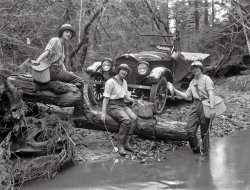
- Texaco Test Car: 1937
- June 15, 1937. Fisherman's Wharf in San Francisco. "Texaco Test Fleet auto at Joe DiMaggio Grotto. Driver of Pontiac ... year old brother Dominic was in his first season with the San Francisco Seals where he finished with a .306 BA with 46 RBI.
On June ... Posted by Dave - 04/06/2015 - 11:20am -
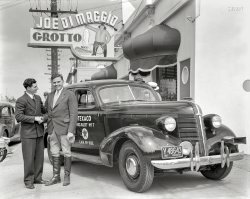
- Sweet Sixteen: 1931
- San Francisco circa 1931. "V-16 at Don Lee Cadillac agency." A sixteen-cylinder ...
Still there The Cadillac dealership, one of many on San Francisco's Van Ness Avenue Auto Row has been converted into a multiplex ... Posted by Dave - 01/28/2016 - 10:42am -
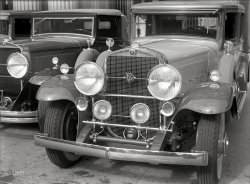
- Our Merry Oldsmobile: 1939
- ... Motors exhibit, Golden Gate International Exposition, San Francisco. Girls in Oldsmobile convertible coupe." Anyone need a lift? 8x10 ... Posted by Dave - 03/31/2015 - 12:33pm -
![Our Merry Oldsmobile: 1939 1939. "General Motors exhibit, Golden Gate International Exposition, San Francisco. Girls in Oldsmobile convertible coupe." Anyone need a lift? 8x10 film negative, originally from the Wyland Stanley collection. View full size.
Santa FeThe model train display in front of the Santa Fe booth looks a lot like the one that was originally built for the Museum of Science & Industry in Chicago by Santa Fe.
The Back SeatDoesn't look as big in this picture from the brochure.
Girls With PluckThat is a shocking lack of real eyebrows there. I wonder how that trend started and when it ended. Not that it has, but I don't think you would find a whole car full of brows plucked that thin nowadays.
Plenty of Room Here!I long for the days when you could get six people in one car without having to buy an SUV or a minivan. Bench seats man!!
Room for One More?Hubba hubba!
It ain't sold yet!"Hey lady, don't get any cigarette burns on the upholstery!"
Beep BeepBrand new and the horn button is already missing?
You take the blonde...and I'll take the one with the turban.
These are MannequinsAlmost had me fooled
It's a really new oneThe pictured Olds is a 1940 model. Headlights seamlessly built into fenders and sculptured lines just above the front wheel cutouts are dead giveaways.
CentenariansMy mother would have been 21 when this was taken. These girls were probably at least that age or older which would make any of them surviving today 100 years old or so.
SROBut plenty of it on the last Olds to have running boards.
Trains On The HorizonI'd like to see a view of the model railroad in the background and check out that giant F7 Engine at the top.
The Ears Have ItTobacconist is right -- definitely Sally. Check the ears (old cop trick -- you can disguise a lot but it's tough to change your ears).
Hellooo, Ladies!
[I hate to burst your bubble (so to speak), but that's not Sally Rand. The incisors (and faces) don't match. Nor do the ages -- Sally would have been 35 when this picture was made. Not to mention the fact that General Motors would hardly be hiring strippers to show off its new cars to the families of America. - Dave]
Model RailroadThere's more about the model railroad in the background and the locomotive on the pedestal here: http://streamlinermemories.info/?p=4463. The model railroad does resemble the one that was in the Chicago Museum of Science & Industry; both were designed by model railroad pioneer Minton Cronkhite.
Those EyebrowsI love this photo! Those faces! My grandmother, born in 1912, plucked her eyebrows too. The idea was that you could make them so much prettier than Mother Nature. You dyed or bleached your hair, you plucked your eyebrows and made them better! It made as much sense to her as adding makeup. I think they were right! It's sexy!
Noise reductionI suspect the missing horn button (spotted by Vintagetvs) was an attempt to keep the exposition hall a little quieter. The last time I went to the (new) auto show here in town, nearly every car on display had the negative battery cable disconnected; this keeps visitors from honking the horn, turning on the headlights or four-way flashers, etc. I assume GM faced the same problems 76 years ago.
(The Gallery, Cars, Trucks, Buses, Pretty Girls, San Francisco, W. Stanley)](https://www.shorpy.com/files/images/SHORPY-298-02.thumbnail.jpg)
- Shell Company: 1919
- San Francisco, 1919. "Shell Oil Co. service station No. 27." Filling something with ...
(The Gallery, Cars, Trucks, Buses, Gas Stations, San Francisco, W. Stanley) ... Posted by Dave - 12/16/2015 - 1:57pm -
![Shell Company: 1919 San Francisco, 1919. "Shell Oil Co. service station No. 27." Filling something with something, and smoke 'em if you got 'em. 5x7 inch glass negative, formerly of the Wyland Stanley and Marilyn Blaisdell collections. View full size.
Hope That Stogie Ain't LitAs a kid who worked his way through high school, and beyond, at a gas station you would not believe the number of customers who pulled in with lit ciggies and cigars and tried to pump their own gas. Even had a truck with refuse in the back on fire that pulled into the pumps wanting water to put out the flames.
Possibly an economy run?Looks like they're filling a one gallon can with a hose connected to the carburetor. Run it until it quits and record how far it went.
Lundburg Shell Service StationPretty sure this is the Shell station that used to be at the corner of Fell and Stanyan until the 1980s. I was a regular there. The wall in the background looks like the wall along the western edge of Golden Gate Park (though the street was widened in the mid 1900s and the grass shoulder removed).
The shrubbery is trying to tell me somethingThere's a topiary message in the foreground, but I can't tell what it is. Pretty sure it isn't "Shell".
Say it with topiaryIt looks like the low shrubs on the lower left are arranged and trimmed to spell out SHELL.
The Park It Is!StanFlouride pegged the location perfectly. The wall of Golden Gate Park in the background is the giveaway. This Shell station was indeed at the NE corner of Stanyan and Fell Streets.
Here's a Google Maps view of the location today.
It's a familiar scene; I went to high school about three blocks away and walked past the station nearly every day in the 1960s.
Could This BeA picture of Jack Benny before he made the Big Time?
Go Ask AliceThe Mad Hatters at tea.
The CarWhat kind of auto is this? Thanks.
[A Maxwell. - Dave]
(The Gallery, Cars, Trucks, Buses, Gas Stations, San Francisco, W. Stanley)](https://www.shorpy.com/files/images/SHORPY-833A.thumbnail.jpg)
- Wills Sainte Claire: 1925
- San Francisco circa 1925. "Wills Sainte Claire Six seven-passenger sedan at ...
(The Gallery, Cars, Trucks, Buses, Chris Helin, San Francisco) ... Posted by Dave - 08/23/2021 - 10:56am -
![Wills Sainte Claire: 1925 San Francisco circa 1925. "Wills Sainte Claire Six seven-passenger sedan at Lafayette Park." 5x7 inch glass negative by Christopher Helin. View full size.
Mr. VersatilityIf your vehicle has a Blue Oval on its nose or your pocket knife holds a sharp edge, you can thank C. Harold Wills.
Shiny!On this and other photos of cars of that era it becomes obvious how much effort their owners (or drivers?) spent taking care of them and polishing them to perfection.
Beautiful, but how do you fit seven?That's a swell car. but how do you get seven people in it?
Checker cabs had folding jump-seats, facing aft. So maybe this car is similar: you put three across in the back row, and then add two more, on the folding seats, facing back.
[Correct. - Dave]
Fun factIn 1907, C. Harold Wills designed the Ford script logo.
Breezy dayAs the blurry eucalyptus fronds attest.
Where there's a WillsThe Wills Sainte Claire Company was founded by C. Harold Wills. He named it after himself, of course, and the Saint Clair river that ran by his factory, but with added 'e's for extra fanciness. The company produced only 12,000 cars from 1921 to 1927. The cars were solid and advanced, but hard to repair and expensive.
Wills was Henry Ford's associate starting from Ford's racing days. He developed the Model T's planetary gear, pushed for vanadium steel for lightness, and even designed the blue Ford logo. After his company went bust, he was okay - he had also invested in steel companies producing vanadium steel!
One of the few flat spotsI wonder if those are the same trees?
Wills MuseumMaybe the company produced only 12,000 cars, but nevertheless there is a Wills Sainte Claire Auto Museum!
And, by the way, Wills had also his own emblem, the "Wills Gray Goose."
(The Gallery, Cars, Trucks, Buses, Chris Helin, San Francisco)](https://www.shorpy.com/files/images/SHORPY-1450.thumbnail.jpg)
- Nash Rumbler: 1926
- San Francisco circa 1926. "Nash Special Six rumble seat roadster at Phelan ... hear her back-seat driving.
(The Gallery, Chris Helin, San Francisco) ... Posted by Dave - 11/07/2016 - 2:34pm -
![Nash Rumbler: 1926 San Francisco circa 1926. "Nash Special Six rumble seat roadster at Phelan mansion." 5x7 glass negative by Christopher Helin. View full size.
That's 2150 Washington Street
QuestionHas does one even climb into that rumble seat? Get a good running jump?
[Cars with rumble seats had steps provided at various places on the curb side of the vehicle. -tterrace]
NiceI love the car. Big wide running boards, and cool rumble seat. It's also nice to see the building has been preserved with a nice cover added to the upper open area.
Mother-in-law's lament"If my daughter had married that nice Bob Gunderson, I'd be riding in a Cadillac now!"
Out-of-it FeelingIt's good for kids together but you definitely are not part of the adult conversation back there, having ridden in one of those seats.
Will never understandhow the fairer sex could ever get into one of these things with grace and aplomb.
[Grace would be riding up front with Aplomb. - Dave]
Rumble alonePut Mom in the back. So I can't hear her back-seat driving.
(The Gallery, Chris Helin, San Francisco)](https://www.shorpy.com/files/images/SHORPY-1057.thumbnail.jpg)
- Career Girl: 1956
- ... on the streets - like PED XING.
[I remember seeing San Francisco's unique Wiley "birdcage" two-color signals up through the 1950s; a ... Posted by Dave - 10/13/2014 - 5:42pm -
![Career Girl: 1956 1956. "New York. 21-year-old Mary Cumming, a secretary in offices of designer Raymond Loewy." Who'll be first to locate this intersection? Photo by Phillip Harrington for the Look magazine assignment "Career Girl." View full size.
Bev & BenThe Beverly Hotel is now known as Benjamin Hotel.
Art Deco Building The building to the right of the Career Girl is the old General Electric Building designed in 1931 by the architectural firm of Cross and Cross. It is currently known as 570 Lexington Avenue.
Beyond Van AlenWhere is the Chrysler Building?
[There. -tterrace]
Women's attireThis was just 59 yrs. ago but I don't see even one lady wearing slacks, shorts or jeans. In fact, it even looks like none of the men are wearing jeans. Of course I prefer the comfort of "easy casual" too, but isn't it interesting to see how times have changed?
Photobomb 1.0The young guy with the Cig is stealing her limelight.
PossiblyEast 51st and Lexington?
[You got it. -tterrace]
J. Pierpont FinchWith the cigarette. I believe in him.
Childs Restaurant'The Nation's Host From Coast to Coast Since 1896'.
Checker A8The left-most vehicle, thought of as the classic New York taxicab for decades. This one must have been one of the first, if this is 1955, as they were introduced late that year.
Red/Green traffic lightsI was amazed when we moved from New York to California in 1953 to find they had inserted a yellow light between the red and green - and they also had lots of writing on the streets - like PED XING.
[I remember seeing San Francisco's unique Wiley "birdcage" two-color signals up through the 1950s; a bell rang at each change. The last one was removed about 1958. -tterrace]
Banker's HoursI don't miss banker's hours - 9 AM to 3 PM Monday to Friday and Friday from 4 PM to 6 PM.
New York's red/green traffic lightsFun2BeMe, by the time you moved to CA in '53, most places outside NYC had the amber light between red and green, and, in fact, it was right about then when NYC finally started to phase in the amber. It took NYC about 40 years to finally replace all of the red-green lights with red-amber-green ones. I am uploading with this reply a picture of an old NYC red-green signal with an even older NYC street sign that I own.
(The Gallery, LOOK, NYC, Phillip Harrington)](https://www.shorpy.com/files/images/SHORPY-06635u.thumbnail.jpg)
- A Pretty Grille: 1927
- San Francisco circa 1927. "Cadillac and swimmers at Fleishhacker Pool." 5x7 glass ... mine!
(The Gallery, Cars, Trucks, Buses, Pretty Girls, San Francisco, Swimming) ... Posted by Dave - 11/02/2015 - 8:22pm -
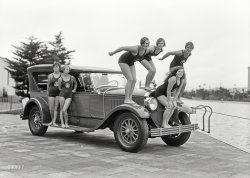
- Tiburon Tommie's: 1969
- ... the anchor. That's me. Tiburon is a Marin County town on San Francisco Bay, and Tiburon Tommie's was a Chinese restaurant with a decor and ... Posted by tterrace - 06/14/2015 - 4:39pm -
![Tiburon Tommie's: 1969 No, Tommie's not the guy with the anchor up ... well, with the anchor. That's me. Tiburon is a Marin County town on San Francisco Bay, and Tiburon Tommie's was a Chinese restaurant with a decor and cocktail selection that today would be called Tiki. Opened about 1955 by Tommie Cox and former Trader Vic's employee Johnnie Won, it closed around 1997 and today exists only in the warm nostalgic memories of older Marinites. This is the bay side of the building, which itself no longer exists. Existing was something that I didn't know this slide did until a couple days ago, when my friend who took it in 1969 and I were rooting around the spare room of his house and found a bunch of slides he'd forgotten about. This one's a 126 Ektachrome taken with a Kodak Instamatic. I recognized those aluminum sticks in the lower right corner as legs of my tripod, so I must have been taking Super-8 movies that day. View full size.
I just happened to be in Tiburon this morningAnd found your is anchor still there.
All the buildings in the background have indeed had major makeovers since 1969, but the anchor must have been to unwieldy to move. It sits a new base, and is ever-so-slightly turned on its axis, but otherwise it's the same.
Curiously, the telephone pole at left seems to have also survived the decades unscathed.
[Excellent, but the dog... where's the dog? The Tiburon Tommie's building was demolished in 2000, I find. -tterrace]
Arfchival?That Ektachrome has held up well. You must have stored it properly.
[Storage was haphazard, I'm afraid. When found it was covered with dust and musty-smelling. It had also been overexposed originally. What you see here is the result of physical and digital reclamation/restoration. -tterrace]
["Arfchival" would refer to the K9 process, yes? - Dave]
Fashion FadWearing the belt buckle off center must have been some sort of fashion statement at the time ;)
[If so, I was unaware of it. Mere sloppiness or inattention on my part, no doubt. -tterrace]
Least dated image on ShorpyApart from the colour cast of the film, there's nothing I can see in this photo that says that wasn't taken yesterday (change of urban landscape notwithstanding!) Even the colour could be someone using a filter in Instagram!
Airedale!Whose Airedale Terrier was that?!!
Wonderful nostalgiaThis is a wonderful photo; you are so lucky to have discovered it!
In 1969, I had just graduated college across the continent in NY (I'm 67), and dressed very much the same way you are in your photo. Wearing the belt buckle "off center" was very much in vogue here at that time. Two reasons: if you wore your shirt tucked in with the buckle exposed, you ran the risk of scratching someone's car as you leaned over the hood to admire the engine, and if you wore your shirt outside, keeping the buckle to the side made you look just a tad thinner, and you certainly wanted the ladies to think you were slim and trim.
I too have a collection of old slides gathering dust in the attic (including hundreds from the '64-'65 NY World's fair), and you have just inspired me to get up there and find them.
Happy Memories!
Turquoise Tommie's?I remember Tiburon Tommie's well - though only went there once. Today there is no beach there - it is all decks for the various overpriced restaurants. Anyone who hasn't been to Tiburon should be told that San Francisco is the big feature of the view to the right in this photo.
One thing about the color - the turquoise in the building roof trim (also on the street side) was bright and striking - one of the most memorable things about the place - so the faded glory in the image is the poor color retention, at least in the blue range. The reds looks great!
Belt buckle Wearing the belt buckle off-center may or may not have been a fashion trend at the time, but guitar players did it all the time to keep from it scratching the back of the guitar. In most of the 1960's Monkees episodes, Peter Tork wore his off center because he was so proud of the new guitar Gretsch donated for the show for his use and he didn't want to hurt it. source: DVD commentaries.
Same year I moved to TiburonThanks for posting this one, tterrace. June 1969 (exactly 46 years ago) was when my family moved us from the foggy climate of Daly City to sun-swept Tiburon. I thought I'd died and gone to heaven.
I was 18 that year and spent a lot of time on Main Street, including a few underage evenings in Tiburon Tommie's. More importantly, I also got a part time job working for Tom Nell Photography, located about five doors down Main Street from Tommie's. Tom was my entree to studio portraiture, artificial light photography, and lots of darkroom time.
I partly grew up in BelvedereI graduated from high school in 1996, that tiki restaurant was never open that I can remember, for all the years while I was there. We went to Sam's a lot. I used to walk past it and look though. A friend of the family owned the little shop right across the street next to that Ark Row parking lot entrance.
-tterraceMay I have the "SKIP" key for this clip?
Thank you.
[It's under the mat. -Dave]
(ShorpyBlog, Member Gallery, tterrapix)](https://www.shorpy.com/files/images/paul_tiburon_tommies_doug_July1969_adj.thumbnail.jpg)
- Three Indians: 1915
- ... to the officials of the Panama-Pacific exposition at San Francisco.
The Washington team, which will cover the first lap, will be ... Posted by Dave - 04/06/2013 - 11:57am -
![Three Indians: 1915 Washington, D.C., July 1915. "Motorcycle team, relay to Frisco." Frank S. Long, F.L. Leishear (whose Indian store we saw here) and Josiah McL. Seabrook. National Photo Company Collection glass negative. View full size.
California, screamin'They sure did take a circuitous route (NYC and then way up to Albany). The stretch from Reno down into Sacramento must have kept the lads awake with fear if that lap's bikes had no front brakes either. The first time I drove from Reno to Sacramento - and this was on a road they could not dream of, I-80 - one item that caught my eye was a sign, "Caution. Downgrades next 40 miles."
Light fantasticThe one smart enough to put the light on his bike will win it for them.
Gold mineThe guys from "Pickers" must be drooling. Maybe they could find out who these men are and see if their families have these bikes behind the barn.
Safety first!At least for the fellow with the tossled hair. He has on his protective gloves!
Rudimentary brakes.Emergency stops much have been pretty exciting on those old bikes- I don't think they even had front brakes. No stoppies for them!
Nice!I've been sitting here soaking up this picture. Just fabulous! Great shot, great clothes, great bikes! Wish I could go for a ride with them.
Thanks again Dave.
Handsome BravesBeautiful bikes! These have many, many similarities to this amazingly restored model, snapped last spring in Charlotte, North Carolina. They may be a bit newer, with kick starter, no leg-power pedals, skirted fender, hand-grip clutch, an electric headlamp on the rear bike (as opposed to Prest-o-Lite [acetylene]), and "soft-tail" rear suspension. I guess any of this could have been optional equipment.
DatingI believe that the date of this photo is probably 1916 and not 1926. The Indians pictured appear to be 1915 models. I believe that 1915 was the last year of the inlet over exhaust engine (which these bikes have)and the first year of the kick starter.
[You are close -- the year is 1915. - Dave]
World's Fastest IndianWhen you see these bikes it really is incredible that Burt Munro took a similar model, a 1920 Scout, modified it and drove it to several land speed records. In 1967, with his engine punched out to 58 cu.in. (950cc) he set a class record of 183.586 mph. To qualify he made a one-way run of 190.07 mph, the fastest ever officially recorded speed on an Indian.
The hogs of their dayLaugh at the funny horn if you like, but those bikes are Indian "standards" with 1,000-cc engines. Too bad they didn't add front brakes until 1928.
Murder Inc.Maybe these fellas were part of the traveling team of hit-men for Murder Inc. They sure look like they want to kill something.
a-OO-gah!Although the braking wouldn't be the greatest, at least they'd be able to clear a path with a mighty squeeze of the horn.
Silent RIt was Shorpy that taught me that these are "Motocycles."
119 Hours to FriscoWashington Post, July 18, 1915.
RELAY RACE TOMORROW
Motorcyclists to Carry Message From Capital to Pacific.
START FROM WHITE HOUSE
Three Washington Men Will Cover the First Lap, From This City to Baltimore -- Expect to Make Cross-Continent Run in 119 Hours -- Secretary of War to Start Riders.
With all arrangements for the transcontinental motorcycle relay race completed, the riders for the first lap of the long journey await the starter's word. The start will be made from the White House at 10 o'clock tomorrow morning. They will carry a message from the President to the officials of the Panama-Pacific exposition at San Francisco.
The Washington team, which will cover the first lap, will be composed of Frank S. Long, F.L. Leishear, and J. McL. Seabrook, mounted on Indian motorcycles. These men will carry the message from here to Baltimore, where another team will take it up and carry it over the second lap which ends in Philadelphia. From there the route across county is via New York, Albany, Buffalo, Cleveland, Chicago, Davenport, Des Moines, Omaha, Cheyenne, Salt Lake City, Reno and Sacramento to San Francisco.
Fast Time Is Scheduled.
On account of the absence of the President, the message will be handed to the riders by Secretary of War Garrison. It is due on the Pacific coast 119 hours after leaving Washington.
The riders in the Eastern part of the country will have little difficulty in keeping up with the schedule on account of the good roads, but some of the Western relays are more than 200 miles in length. The longest lap will be between Elko and Fenley, Nev. This stretch is 274 miles long.
One of the purposes of this relay is to demonstrate the utility of the motorcycle for military use. The relay is intended to show that the motorcycle is capable of delivering messages under all conditions of road and weather. There will not be one minute from the time the message leaves Washington until it is delivered to the officials of the exposition that it is not moving, day and night, rain or shine. The motorcyclists of this country have been as one volunteering their services as dispatch bearers, and it has been a task for John L. Donovan, chairman of the competition committee of the Federation of American Motorcyclists and manager of the relay, to select the riders.
HornyThe furthestmost bike from us has an electric horn, but the others have the bulb variety; I'm guessing it was an optional extra or later add-on. Also interesting to note that heavy cardigans seemed to be the outer garment of choice for moto-cyclists at this time. I wonder when and why the black leather jacket took over.
Front SuspensionIt's called a trailing link suspension as the arm pivots ahead of the axel axle. Not too common at all. I believe some early BMWs used this type for awhile as well.
In All It's Its GloryHere is a picture of a restored bike that is exactly like the ones in the picture. Note the kick start is on the left side and there is no gear shift to the left of the tank. Apparently slightly later models had the space occupied by the kick start mechanism replaced with a transmission that included a gear shift from it to the left side of the gas tank.
Front SuspensionThe Indian front suspension was designed so there was caster to the wheels. According to the old guys I knew 60 years ago, this caster made for very secure handling and less tendency to high speed wobble. You haven't lived until you have experienced a case of high speed wobble!!!
UnpunctualThe messages were delivered 36 hours late according to the article below from The Salt Lake Tribune from July 26, 1915. Research indicates that the riders were trying to show that taking a dispatch on a motorcycle across the country would be faster than placing the same message on a train. As originally scheduled, the race would have gone through Sacramento during the national Federation of American Motorcyclists (FAM) convention in Sacramento, but this did not happen because of the belated arrival of the dispatch rider. The FAM was the organization behind the race. All riders were asked to conduct a rehearsal ride on July 11th.
The purpose of riding in teams of three was to ensure that if something happened to the primary rider or his motorcycle another rider would be immediately available to continue the mission to San Francisco. Of the three riders pictured here, Seabrook punctured a tire before reaching Baltimore, and he dropped out; Long ran into a pile of rocks in Baltimore, and he was injured; so Leishear became the only man to make it to the first transfer point.
By Bryan, Ohio, near the Indiana border, the racers were five and a half hours late because of rains and bad roads. By the time the riders reached Chicago they were 12 hours behind schedule. Some time was made up on the way to Moline, Illinois as the deficit was reduced to just eight and a half hours upon arriving there, and seven hours at Des Moines, Iowa. In Nebraska the lead rider had an accident, but the other riders were far behind him. Consequently, by Rock Springs, Wyoming the riders were 19 hours behind their scheduled arrival, and at Ogden, Utah 18 hours overdue. I did not find where the other 18 hours were lost, but many sources mention the 36 hour late arrival.
The official route, dates, and times as originally scheduled were shown in the Ogden Standard (Ogden, Utah) on July 17, 1915. Note the earlier start time than what actually took place.
July 19: 6:00 AM, Washington. D.C. to Baltimore, Philadelphia, New York, Poughkeepsie, Albany, Utica, Syracuse, Rochester to:
July 20: 12:45 AM, Buffalo, New York to Erie, Cleveland, Toledo, Bryan, South Bend, Chicago, Sterling, Davenport to:
July 21: 3:15 AM, Victor, Iowa to Walnut, Omaha, Columbus, Kearney, North Platte, Julesburg to:
July 22: 3:15 AM, Cheyenne, Wyoming to Pine Ridge Station, Rawlins, Rock Springs, Evanston, Salt Lake City, Ogden to:
July 23: 12:45 AM, Kelton, Utah to Cobre, Elko, Rye Patch Station, Battle Mountain, Tenley, Reno, Colfax, Sacramento, Tracy, to San Francisco.
(The Gallery, D.C., Motorcycles, Natl Photo, Sports)](https://www.shorpy.com/files/images/32280u.thumbnail.jpg)
- Crossing Guard: 1937
- San Francisco, 1937. "Don Lee Oldsmobile on Golden Gate Bridge with police ... deck and the casual (parked) stance of the subjects, San Francisco's signature span must have been in its final days of ... Posted by Dave - 05/04/2015 - 8:16am -
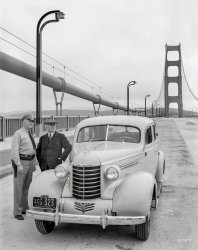
- Mr. Right: 1920
- San Francisco in 1920. "Oldsmobile touring car." Its dapper driver signaling either ...
The trees and flagpole in the background are inside San Francisco's diminutive Fort Mason on the north waterfront, while at extreme ... Posted by Dave - 10/21/2014 - 1:00pm -
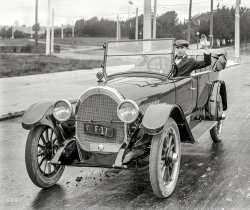
- Golden Cargo: 1920
- ... "Two Tons of Oranges -- the Gift of the Alhambra-San Gabriel Red Cross Chapter, to the Sick and Disabled Soldiers at Letterman Hospital, San Francisco. Your Turn Next!"
This legend in ... Posted by Dave - 04/22/2015 - 9:08pm -
![Golden Cargo: 1920
Fruit as First Aid to Convalescence
"Two Tons of Oranges -- the Gift of the Alhambra-San Gabriel Red Cross Chapter, to the Sick and Disabled Soldiers at Letterman Hospital, San Francisco. Your Turn Next!"
This legend in bold letters on the side of a two-ton auto truck advertised the merits of fruit as a first aid to convalescence over a circuit of five hundred miles, as the golden cargo made its way along the valley of the Southern California town on to the Pacific Coast. Newspapers all along the route gave a still wider publicity to the generosity of the Fruit Growers of the Sunset state for in addition to the oranges there were quantities of lemons and grapefruit, while at Los Angeles the local Red Cross Chapter added a contribution of seventy-five pounds of candy.
--Better Fruit, June 1920
March 1920. "Republic motor truck at Letterman Hospital, San Francisco, with cargo of oranges." 5x7 glass negative by Christopher Helin. View full size.
In the dayswhen men were men and tires were solid!
Before Agricultural InspectionHow they got it across the California border is a question.
[They wouldn't have to, since they started out in California. Hello? - Dave]
Fruit Was Always WelcomeMy father spent almost two years at Letterman Hospital during WWII and said the most excitement among the patients, all soldiers, was the arrival of fresh fruit, especially watermelons and lettuce.
(The Gallery, Cars, Trucks, Buses, Chris Helin, Medicine, San Francisco)](https://www.shorpy.com/files/images/SHORPY-320-03.thumbnail.jpg)
- Chinatown: 1900
- San Francisco circa 1900. "Chinatown. The street of the gamblers at night." Nitrate ... of a business.
Great site btw!
(The Gallery, San Francisco) ... Posted by Dave - 09/09/2011 - 12:57pm -
![Chinatown: 1900 San Francisco circa 1900. "Chinatown. The street of the gamblers at night." Nitrate transparency by Arnold Genthe. View full size.
Throwing Heaven and NineA dice game popular with Chinese immigrants around this time was called "throwing heaven and nine" or "chak tin kau." The game was played with two dice, with the different combinations divided into two suits. Players wager that the shooter will not throw the highest combinations. Rules can be found in the Archives of the University of Waterloo Museum of Games.
http://www.gamesmuseum.uwaterloo.ca
"Teneha, Timpson, Bobo & Blair!"
Goober Pea
Mirror imageJust letting you know, the image has been flipped. you can tell by looking at the Chinese characters in the current top left and bottom right corners.
[Thanks. I have flipped it around. What do they say? - Dave]
Ross AlleyGood photo. "The street of the gamblers" is formally known as Ross Alley, which runs from Sacramento Street to Washington Street, between Grant Avenue and Stockton Street. It is still a busy place, and it contains a wonderful fortune cookie factory.
Regards,
Joe Thompson
Translationliteral translation of the Chinese characters:
The top two characters:
call to wealth
The bottom four characters:
welcome the god of wealth
These are common decorations (lucky charms) for the entrance of a business.
Great site btw!
(The Gallery, San Francisco)](https://www.shorpy.com/files/images/7a55104u.thumbnail.jpg)
- The Only Way to Fly: 1965
- ... stretch out and light up on a nice, comfy flight from San Francisco to Hawaii in 1965. Someone borrowed their Kodak Instamatic for this ... Posted by tterrace - 10/06/2015 - 6:42pm -
